End Of Unit Reflection
By Ayla Styles
This term our focus was on Ahurea/Culture. My first impression on this led me to think that it was going to be an easy assignment. Culture just means culture, there’s nothing else to it. I then realised that culture means so many different things, and there is really no telling what it could mean to someone else compared to you.
Our first task for this unit was to choose a European country and pick two subjects related to things that could mean culture and explain the differences and similarities between those things in the European country and New Zealand. For our European country we picked France, then for our subjects we chose food and sports. Now we had to think of cultural food and sporting activities from both countries to compare.
France SSC -Hope, Ayla and Ella
Then for the second part of the Unit we picked an Asian country, India. But the assignment was a bit different, we were to pick one or two subjects to base it on and research into those things to find out how to properly understand them. We chose to research Indian dance and their hand movement in their dances that they use to tell their stories. We learnt alot about how they use eye contact and feet, leg and hand movements to tell their very special stories. We even learned how to tell a story ourselves, called ‘The tales of the Lion and the Mouse’ .
Indian dance movements -Ayla Styles
In conclusion the whole Ahurea/Culture Unit was very interesting and I definitely think that I learnt alot about how different the simple word culture can mean to so many people. I was very surprised to learn what it meant to lots of cultures and it helped me to understand what my take on the entire Unit was and my opinion.











